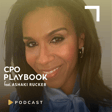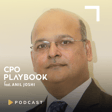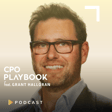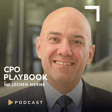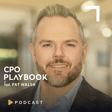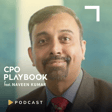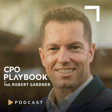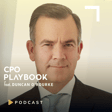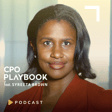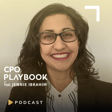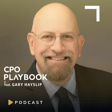Introduction to the CPO Playbook
00:00:03
Speaker
I'm Felicia Shakiba, and this is CPO Playbook, where we solve a business challenge in every episode.
The Risk of Not Integrating AI
00:00:16
Speaker
Three out of four organizations are at risk if they don't navigate scaling AI within their operations, according to Accenture. It's not merely about chat GPT experimentation anymore. Leaders in the C-suite are aware
00:00:31
Speaker
The progressing beyond-mirror experimentation to a full-blown integration of chat GPT is now synonymous with the survival of their organizations.
Exploring ChatGPT for OKR Design
00:00:40
Speaker
In this episode, we're bringing you an exclusive collaboration that could reshape the way you perceive chat GPT integration.
00:00:47
Speaker
Discover how an organization can create unprecedented value as I team up with our special guest to unveil the realm of ChachiBT assisted OKR design. Joining us is Enrique Rubio, the visionary founder of Hacking HR. Together Enrique and I will take you through a live demonstration of designing objectives and key results, also known as OKRs, with the power of ChachiBT.
Tech Startup Growth Case Study
00:01:13
Speaker
To get started, Enrique, first of all, thank you so much for being here.
00:01:18
Speaker
Thank you, thank you so much for inviting me to be part of your show and have this conversation. You and I have created a case study, and here it is. ABC Enterprises, a tech startup, is projected to achieve 20% growth in the coming year. As the People Operations Team, the challenge is to develop strategies that enable this growth by optimizing the workforce and enhancing overall employee effectiveness.
00:01:46
Speaker
So essentially, our objective, which we can adjust if needed, is to enable and drive ABC enterprises 20% growth through strategic people operations support.
Combining ChatGPT and Human Insight
00:02:00
Speaker
So as we get started with chat GPT to help us design this OKR, which is objective and key results, where do we start?
00:02:10
Speaker
Well, let's start here and it's more of a foundational component rather than actually using the tool, right? Which we will do. The chat GPT is not perfect, neither. It is the response the human would give to any issue, right? There's always room for improvement.
00:02:28
Speaker
And I want to say that because the best case scenario will always be the collaboration and the partnership between Chagipiti and the human. What this means is that whatever you ask Chagipiti, it will never be perfect.
00:02:45
Speaker
whatever you respond on your own, chat GPT will probably try to do it better. But when you do it together, that's always the best case scenario, as I mentioned before. So as you're asking questions to chat GPT, which we're going to be doing now, bear in mind that number one, we're doing this exercise real time as we're recording this podcast. But number two, when you do it on your own for whatever practice or whatever problem or whatever thing that you're working on in your practice, in your age of practice or whatever you do at work,
00:03:14
Speaker
just understand that you can't take chat GPT's input or response to your questions as the final word on anything. You have to add the human element, whether that is in the form of asking more questions to get a more refined answer, or whether it is at the end of the journey, you may need to go back to that answer and reframe it in a way that doesn't sound too computerized, perhaps that sounds more
00:03:38
Speaker
like a human right so in this case right so imagine that you are a small company right you are say ABC enterprises I don't know maybe you are a 500 people company or a one our personal company you may be just two up to maybe three people working in your HR department if at all you may have a an HR strategist and maybe you have a one admin in HR and maybe one recruiter
00:03:58
Speaker
and you're trying to grow your company by 20%, which is a conservative number if you are in the startup world over the next one year. So if you are in this role, imagine that you are a new leader in this role and you are just leading that company and your mandate is, help us grow this company by 20% next year.
Identifying Business Priorities with ChatGPT
00:04:18
Speaker
So I'm going to go to chat GPT right now, which I have opened on version number four. You can use version number three point five or version number four. Three point five is a little faster, but less accurate, perhaps than version four. So I'm using version four and it may take a little bit of extra time to do this. Right. And bear with me, by the way, because you may hear the sound of my typing in the keyboard. So I want to ask. I'm going to say something. ABC Enterprises is, I don't know, a 100 person company aiming to grow by 20 percent next year.
00:04:46
Speaker
I am the HR leader for the company. This is what I'm writing for the company. And I want to know what areas should be my priorities for the next year in order to achieve the 20% growth goal. Let's see what Chatea Bitti says, right? And of course, achieving a 20% growth, it's giving you
00:05:06
Speaker
You know, a little bit of an answer here. It's not just a responsibility. That is the first paragraph that is saying, thank you so much for telling us that growing by 20 percent is not just a responsibility. It's everybody's responsibility. And then you go. It's telling us right now, I want to try to bring up some of the top priorities that are coming up in here.
00:05:23
Speaker
recruitment and onboarding, scalable recruitment process and an effective onboarding process, training and development, upskilling current employees, leadership development, performance management, clear KPIs and goals. We're going to be talking about OKRs right now, feedback and reviews, retention strategies, culture and communication, workforce planning. It continues to tell me more answers, but I'm going to stop there one second. Felicia, I want to go back with you.
00:05:46
Speaker
And from these answers in here, recruitment and onboarding, training and development, performance management, retention strategies, culture and communication, workforce planning, diversity and inclusion. And the thing continues to spit out more answers. But from this top 10, Felicia, which one do you want to work on right now? And by the way, everybody, we're doing this real time. So we did agree on a case before coming to this recording. But what we're doing is real time. So bear with us. So Felicia, just pick one of these.
00:06:16
Speaker
Yeah, thank you so much, Enrique. This is so amazing to see. And as I'm watching chat GPT share these answers, my mind is moving fairly quickly and a lot more questions than answers are coming up for me. So for example,
00:06:32
Speaker
When I think about workforce planning, because if you don't have workforce planning properly laid out, it's really difficult to say, okay, if we are going to grow by 20%, what areas of the business do we need to grow in? If you think about work
00:06:50
Speaker
workforce planning and you also think about succession. For example, if we have to find someone to fit like head of technology or head of engineering, let's say, there might be somebody inside the company that might fit that role better that we could put in that place instead of look outside the organization. If we don't have workforce planning and that
00:07:15
Speaker
succession element in place first about where people need to be in the next year. I think it's going to be really difficult to pinpoint who we want to recruit and what type of roles we want in the organization. So I think one of the first things that I would do is really look at how are we going to move people that we already have within the organization before we even get to streamlining recruitment.
Challenges in Workforce Planning
00:07:40
Speaker
Yeah. Yeah. Well, that's a great example. Strategy number six, speed out by chat GPT is workforce planning. And let's just dig a little deeper into that one, right? Let's see what happens. So I'm going to ask chat GPT again. I want, I'm gonna say here, I want to focus on developing a workforce planning strategy for ABC enterprises.
00:08:03
Speaker
What may be the challenges, let's say just for now, and then we're going to go to the OKRs, by the way, what may be the challenges around doing workforce planning? Because it's a small company. I'm a new leader. I have no idea what challenges I'm going to be dealing with. And I would like to know, right, I mean, if chat GPT is giving you answers from aggregate information from around the world.
00:08:23
Speaker
So, you know, there are thousands of other HR leaders who have said in the past, if I am growing a company from 100 people to 150 or 200 people, whatever it is, these are the 10 challenges that I have dealt with when it comes to workforce planning. Me as a new leader in this role, I may want to know that so that I keep an eye on those challenges. So that's why I'm asking for ABC enterprises, what may be the challenges around doing workforce planning?
00:08:46
Speaker
And what should be the priorities for an HR strategy focused on only, let's say for now, on workforce planning? I just want to see what it says. Again, I haven't asked these questions before to judge GPT. So whatever we're getting here is going to be new for you listening or watching this video or for me. So forecasting demand, accurately predicting the number and types of roles required, what you were saying before Felicia, we need to know where the team is going to be growing.
00:09:12
Speaker
talent pool shortage, making sure that we know where there may be some scarcity, balancing current needs and future needs, cost implications, changing business environment, retention data accuracy, cultural fit. Those are some of the challenges for ABC enterprises. Again, these are very general questions. Don't expect this to know everything about ABC enterprises if you haven't given the software chat GPT all the information that it may need to give you an answer.
00:09:37
Speaker
So, of course, when we talk about priorities for a workforce planning strategy, it's going to give you some very general ideas, right? Clear understanding of business goals. Evidently, if you're an HR leader helping out your company to grow by 20%, you're going to have to talk to all the other leaders to know where the team is going to be growing and where they want to put the most amount of effort. For example, imagine that in this company, they want to put the most amount of
00:09:58
Speaker
effort in growing the, I don't know, the development or engineering team. So that's going to give you some insights that you can feed back into chat GPT data driven decisions, the skills gap analysis, flexible recruiting strategies. So it gives you a bunch of different ideas here of what you could do in your HR strategy as priorities when it comes to workforce planning. So, you know, I'm going to just pick one of these, right? I'm going to say ABC enterprises.
00:10:25
Speaker
wants to grow, I don't know, the engineering and development team faster than any other teams. I don't know if this is real. I'm just making it up, right? Engineering teams. What should we do when it comes to workforce planning for the engineering team?
00:10:40
Speaker
Again, very general question. As you give chat GPT more information, it is going to be able to give you better responses. Again, no response will ever be perfect. Some of this will be very general, some others will be very specific, and you will have to play with that. The point is that it's giving you a lot of information, some of which you may have thought about before, and some of it may be completely new for you.
00:11:05
Speaker
Like, I mean, you'd be surprised still today how many HR leaders spend in high growth companies, spend so much time in recruitment strategies, and they forget the quality of the onboarding and the quality of the cultural experience for those employees. So you end up spending a lot of money trying to expand your talent by whatever amount is needed to meet company needs, only to see them go three, six, nine months down the road because the onboarding wasn't proper,
00:11:35
Speaker
or there was no cultural alignment or fit between that person and the needs of the company. So if you didn't even think about that before, ChatTPT gave us those insights. And now you may say, oh, I didn't think about onboarding before, so now I am thinking about it. And in fact, when I asked this latest question that I asked about ABC Enterprise who wants to grow the engineering and development team, how should we think about workforce planning for that specific team? There are some answers here that are very general, and one of them is onboarding.
00:12:05
Speaker
ensure a comprehensive onboarding process that acquaints new hires with the company's tech stack, coding, et cetera, and assign a mentor to help those new hires. And I'm going to ask here, can you suggest some OKRs for onboarding of new engineering and development team? Please take into account that this is a new company. I'm just adding a new element here of information, right? That's something that I didn't say before.
00:12:28
Speaker
that this is a new company, leaders, some leaders are inexperienced people, leaders, and the company is, I don't know, I'm going to say this, is laser focused on growth. Let's just see what happens here. I don't know what's going to come up with. So I asked for some OKRs here.
Optimizing Engineer Onboarding with OKRs
00:12:43
Speaker
So now LGBT is thinking a little bit about this. It took a little bit of time to think as opposed to the previous questions, right?
00:12:48
Speaker
So it's a little bit less general. So now we got a few answers in here. Objective number one is streamline the onboarding process for engineering and development team. And it gives you some data, reduce the time from hiring to a new engineer's first code commit by 15% of the next quarter. That's very interesting. I wouldn't have thought about that specific goal. By the way, this generally is called time to productivity, right? When from the very first day,
00:13:11
Speaker
that a person comes in the door to the very first day that they actually deliver results that can be quantified. That's a very powerful indicator. I didn't think about that, but in this case, it is telling us, reduce the time from hiring to a new engineer's first code, commit by 15% over the next quarter. So this may not make sense at all for you, or in May, maybe you didn't even think about this before.
00:13:34
Speaker
Let me go to another goal here. Objective number two, equip new engineers with necessary knowledge and tools efficiently. And one key result that is proposed by GPT in this case is ensure that 95% of new hires are paired with a mentor or body within the first three days. That is fantastic.
00:13:52
Speaker
Again, you may have thought about this, but it took us literally, what, five minutes to create these OKRs and these key results with Chagipiti. Some of them may not make sense for you. Now it's a human element bringing that to your board and thinking, does it make sense to say in the first three days? Maybe we say 100% in the first week or 75% in the first two days. You decide what makes sense for you. But these are powerful insights that you can use to leverage on. So anyway,
00:14:19
Speaker
I'll stop there for a second, Felicia, because I think I've said a lot so far. Enrique, I think that, first of all, you did an amazing job sharing this journey and how we got here. So thank you for that. And one of the things that I think when I'm working with clients, they forget that just because it is HR's objective to help support these new leaders in the hiring process,
00:14:45
Speaker
They forget that OKR also needs to be shared with those hiring managers. And just thinking about, for example, if you move up the page just to object that I think number three, strengthen leadership skills among new and existing team leaders. So that is really about helping those leaders who do need to grow their team and making sure that they understand what the hiring process looks like and feels like.
00:15:11
Speaker
what their expectations are for onboarding new employees. And they should actually share this objective, but could have different key results in their line of thinking. I know we are getting short on time, but I want to dig deeper, a little deeper into one element of what you just said, which is the working out of a goal or an OKR together with our peers so that it's not just us who are accountable for those OKRs. So I'm going to go to
00:15:41
Speaker
the response that chat GPT gave before. So objective number three says strengthen leadership skills among new and existing team leaders. Remember that we were talking about before we gave chat GPT a context. We said, not only are we talking about ABC enterprises, now we're telling you that most of the leaders from this company are inexperienced leaders. So maybe they are younger people that are beginning their journey or whatever it is, right? So that was objective number three.
00:16:07
Speaker
And the second key result for that objective was achieve a 20% reduction in new higher queries and concerns escalated to HR, indicating better problem resolution at the team level. I love that, by the way. I'm going to copy that
Engaging Hiring Managers in Team Issues
00:16:23
Speaker
literally. That's what I'm doing right now. I'm going to copy that.
00:16:25
Speaker
I'm gonna go back to the chat GPT and I'm gonna quote it and I'm gonna say, can you please, I'm gonna reread the result, achieve a 20% reduction in new higher queries and concerns escalated to HR. This is fantastic, by the way, let's work for HR because we're focusing on other things, making sure that
00:16:42
Speaker
these queries are resolved at the team level if they can be resolved there, if they don't have anything to do with HR, of course. So I'm asking Chagipiti, for that specific result, can you list several ways to, I don't know, I'm gonna say here, to influence hiring manager or team leader to do this together with us in HR? I just wanna dig a little deeper here in this question.
00:17:04
Speaker
By the way, talking about prompts while we get here, the response. So many cheat sheets on prompts to Chagipiti. Forget about those cheat sheets, by the way. Just imagine that you're having a conversation with somebody. That's the way you have to think about this, right? Imagine that you're having a conversation with another human.
00:17:20
Speaker
But when you imagine your conversation that way, that if you ask a question to another human and that person responds back to you and you're not getting the kind of answer that you were looking for, what you do is just you give, you ask another question, a follow-up question,
00:17:35
Speaker
or you provide more context, or you provide more information, or you ask for clarification. It's the same thing here. Don't think about those prompts. Think more of it as you having a conversation with another human, getting an answer. If the answer is satisfactory, fantastic. If it's not, which most likely will not be at the very beginning, ask more questions, provide more context, request more information and whatnot.
00:17:58
Speaker
So I ask that question for key result number two, can you list several ways to influence the hiring manager or team leader to do this together? And when I say this, it means to have new employees resolve their questions at the team level and not back to HR.
00:18:13
Speaker
And then it provides a number of answers, educate on the importance of this and that, empowerment and training, open communication channels, provide tools and resources. Some of this may be very general. Some of these answers, you may have thought about them before, and maybe some are completely new for you. But once again, I'll stop here because I think we're getting up on time. But I think this is a good way to approach these kinds of conversations. And you can have them as whatever ways you want.
00:18:40
Speaker
chat GPT right now literally every day for a number of different things from helping me design learning and development programs to just reviewing a letter that I'm using to invite a speaker to one event, things of the kind. And the answer that GPT will give me will always depend not only on chat GPT, but on the kind of questions and the context that I am providing. And always the best case scenario will be how you ask those questions, how you provide that context.
00:19:08
Speaker
how you take the answer or the responses that Chatea Pitt is giving you and how you add your own human element to it and decide what makes sense, what needs reframing, what needs rework, and what can be left
Collaborative Problem-Solving with ChatGPT
00:19:20
Speaker
as is. Enrique, this has been amazing. I almost think that I would encourage people who are listening to this
00:19:28
Speaker
to work with not just chat TPT, but work with someone like another human or a group together with chat TPT, which I don't think I ever really thought about before, because I thought, why would I need like so many people in the room when chat TPT has all these amazing ideas? But at the same time, I think that the rift between you and myself made this so much more applicable and made more sense that I think that chat TPT isn't just an assistant, it's a collaborator.
00:19:57
Speaker
Imagine you and I just did in 10 minutes, right? Imagine if you and I were part of that team from ABC Enterprises working this out and coming together and saying, hey, Felicia, let's spend the next hour or couple of hours literally playing with 2GPT. That's what we're doing. We're playing with 2GPT and 2GPT is giving us answers and we're like, whoa, I didn't think about that. Let me dig a little deeper here. Let me dig a little deeper there.
00:20:18
Speaker
And then you start getting more and more insights, more ideas, and it's powerful. So that again goes back to what we said before, the collaboration between the technology and the human. And if there are more humans, more than one human involved, even better, because the interaction between those two humans can improve the kind of questions and context that you're providing to GPT. So I love that, that point that you just made. Thank you so much Enrique for being here. This was amazing. Thank you.
00:20:48
Speaker
That's Enrique Rubio, founder of Hacking HR. If today's episode captured your interest, please consider sharing it with a friend or visit cpoplaybook.com to read the episode or learn more about leadership and talent management. We greatly appreciate your rating, review, and support as a subscriber. I'm Felicia Shakiba. See you next Wednesday and thanks for listening.



